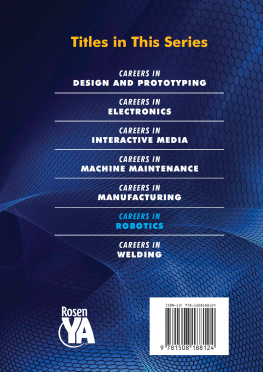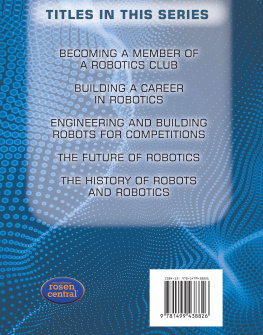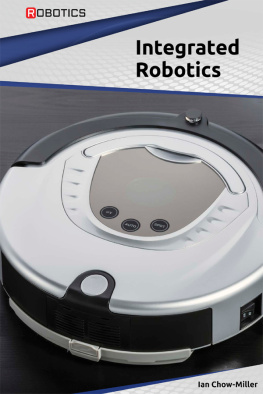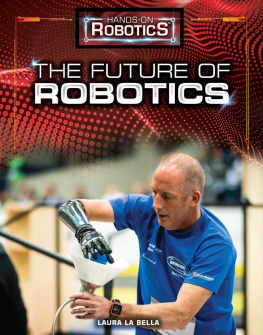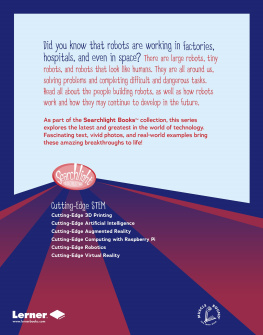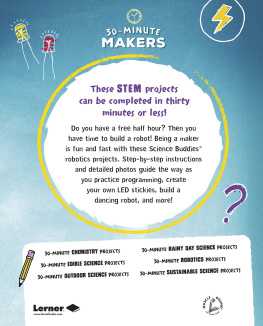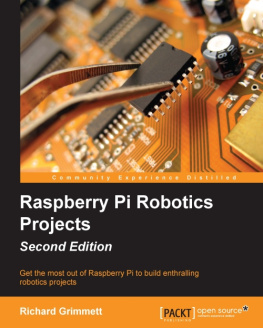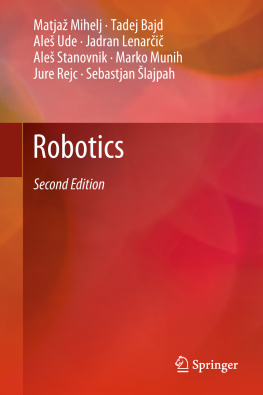Whenever we talk about robots, many people get an idea of a machine imitating a human, like robots from Terminator or Star Wars. These are the ones found in science fiction movies, robots with the consciousness. However, in reality they don't exist with such superior thinking. Though we have successfully given enough common sense to robots for interacting with this dynamic world, we couldn't give consciousness to a robot. Giving common sense is one thing but giving consciousness is on a whole different level. Many industries and scientists are trying to create such humanoid robots.
The type of robots that we encounter frequently are the ones designed to do tasks that are too onerous, boring, dangerous or just plain nasty. The robots present in this world out of this kind. They are being widely used in the areas of manufacturing, automobiles, medicine and space. Robots have become a part of our lives directly or indirectly. In this book we will discuss about the second type of robots.
For one to understand the concept of robotics, he should have decent knowledge in the areas of electronics, mechanics and programming. With the increasing use of robots in our day to day lives, one can actually find a good career in robotics. You can start learning robotics by making simple robots. These are actually fun to use.
I hope you find this book useful and I thank you for using this book.
Chapter 1: Robots
In the year 1979, the Robot Institute of America defined a robot as
"A reprogrammable, multifunctional manipulator designed to move material, parts, tools, or specialized devices through various programmed motions for the performance of a variety of tasks".
Webster defined a robot in a more inspiring way as "An automatic device that performs functions normally ascribed to humans or a machine in the form of a human."
Origin of the Word Robot
Karel Capek (1890-1938), a Czech playwright, used the word robot for the first time, from the Czech word meaning serf or forced labor. He was very prolific and influential as a playwright and a writer. Because of his works, he was considered as a candidate for Nobel Prize, reportedly for several times. He used the word robot for the first time in his play in the year 1921. This play is about robots and the advantages they bring. The play ends ironically with blight in the form of social unrest and unemployment. The theme of this play, in part, was to the show the dehumanization of man living in a technological civilization.
You may be surprised to hear this but robots were not mechanical. They were created through chemical means. Capey fought this idea was possible in his essay in the year 1935.
We can say that Capeks brother Josef, a writer, actually coined the word robot. This evidence says that Capek asked Josef in a short letter, on the name to be given to the artificial workers in his play.
Capek suggested the word Labori and thinks that this world is too bookish. His brother, Josef muttered, Call them robots and goes back to his work. And so, we have the word robot from a curt response.
First Use of Word Robotics
Isaac Asimov used the word robotics, in his short story Runaround, for the first time in the year 1942. A collection of the stories, I, Robot, was published in the year 1950.
Rob therapist was one of Isaac Asimovs first works on robots. Eliza is the modern counterpart for his fictional character. A professor from MIT, Professor Joseph Weizenbaum, wrote Eliza in the year 1966. He described it as a computer program for the study of natural language communication between man and machine.
She was designed to simulate a psychotherapist with her 240 lines of initial code. She was designed to answer the questions with questions.
Three Laws of Robotics
In his work I, Robot, Isaac Asimov proposed the three laws of robotics. Later, he added the zeroth law.
Law Zero : A robot may not injure humanity, or, through inaction, allow humanity to come to harm.
Law One : A robot may not injure a human being, or, through inaction, allow a human being to come to harm, unless this would violate a higher order law.
Law Two : A robot must obey orders given it by human beings, except where such orders would conflict with a higher order law.
Law Three: A robot must protect its own existence as long as such protection does not conflict with a higher order law.
Unimate- The First Robot
In the year 1956, during the Second World War, there was a technology explosion. It is this historic meeting between Joseph F. Engelberger, an engineer and George C. Devol, a successful entrepreneur and inventor, which laid the foundation to the robotics industry. They discussed the works of Isaac Asimov.
They both made a commercial and serious decision of developing a real, working robot. They successfully persuaded Norman Schafler from the Condec Corporation located in Danbury that they can make it a commercial success.
Joseph F. Engelberger then started a manufacturing company called Unimation. Unimation stood for universal animation. This was the first commercial company that started making robots. George C. Devol took care of writing the necessary patents. They named their first robot Unimate. And for this reason, Joseph F. Engelberger is considered as the father of robotics.






